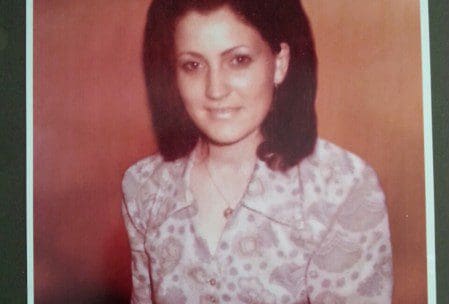The killing of teenager Marian Brown is recorded as the prosaic "Mulhouse Shooting" in secret British Military archives.
The mill on Mulhouse Street had been taken over by the British Army as barracks.
Three other unarmed teenagers were also hit in the shooting including Thomas Corrigan, Marian's boyfriend, her sister and another local teenager. Their friends who dived for cover were also very lucky not to be hit. "Mulhouse Shooting" does not cover the horror of that night.
Marian died at Roden Street/Grosvenor Road, Belfast, in June 1972, after being shot in the neck and body. The British army blamed her death on Republican gunmen who they said attacked one of their patrols from a car. In 2018, though, the coroner at the new inquest in Belfast judged it is “more likely than not” that a British soldier killed her and that the force used was “unjustified” (Belfast Telegraph report).
The British Army did not follow its own so-called Yellow Card Rules as the soldier(s) who fired the fatal shots had no clear target, no clear line of sight, and called no warnings.
But the circumstances of the killing were still disputed. Civilian witnesses, including those who were also shot and injured, testify that they saw no Republican gunmen and heard no fire before Marian and the other civilians were shot. At no point did they see or hear the suspected car alleged by the British Army to have been used in the attack.
What makes the killing of Marian Brown more poignant is not only that the British armed forces covered up the circumstances of her death and that her family have fought for two generations for the truth, but also because Marian’s family did not know that she was pregnant at the time.
Her family only discovered that she was carrying a baby when they were both killed when the Historical Enquiries Team (HET) reviewed her post-mortem files 40 years later.
In a heart-breaking interview with Maurice Fitzmaurice in the Mirror, Marian’s brother, Richard, said:
“It’s two people I lost that day… Our mother passed away and she never knew about the grandchild she never had.”
The HET also reported that she was shot with a 7.62 round used by the British Army at the time and that “the account given by some of the troops” regarding the return of fire “lacks credibility”.
NEW INQUEST and CIVIL PROCEEDINGS
It was with this new evidence that the family’s solicitors, Ó Muirigh Solicitors, successfully petitioned the Attorney General for a new inquest.
On foot of the conclusions of the new inquest in 2018, Ó Muirigh Solicitors initiated civil proceedings against the British Ministry of Defence (MoD).
Yesterday, prior to the hearing at High Court Belfast, the MoD settled with the families under confidential terms, with MoD also agreeing to pay the family's costs.
The British Ministry of Defence made no admission of liability and the families' solicitor, Eoin Murphy said:
"Our clients are extremely satisfied with how this litigation has concluded. This conclusion would not have been achievable for the positive findings of the related Inquest proceedings."
The result of this long family campaign for truth and justice is proof yet again how insidious the British Government's planned amnesty for conflict-related incidents actually is. Under Britain's proposals, the victims would not have been able to progress through Inquest and Civil proceedings and much of the new information may never have been uncovered.
PAPER TRAIL INVESTIGATION
In 2017 before the beginning of the new inquest, the Coroner’s Service asked Paper Trail if it could locate any archival evidence from contemporaneous files relating to the killing of Marian.
We discovered critical files which were closed at the National Archives and prepared a targeted list of files in MoD repositories that could be accessed by the Coroner.
We also retrieved a file with critical evidence which was subsequently closed by the British Ministry of Defence. We made it available to the Coroner.
The file was a British Army Headquarters Northern Ireland (HQNI) Commander’s Diary for June 1972 which offered a record of reports filtered within minutes from British Army Battalion and Brigade to HQNI.
It proved that the British Army reported firing between 27 rounds (as recorded by the judge in the new Inquest) and 40 7.62 bullets in the vicinity of the shooting of Marian and the other civilians.
Not only did we prove that 3 Royal Anglian patrols were involved in what they called the “Mulhouse Shooting” but also a unit of the 7th Parachute Regiment Royal Horse Artillery (7 RHA).
The British Army patrols reported alleged sightings of individual gunmen at different locations in the area but, significantly, there are absolutely no reports of gunmen in a car.
This information would have been reported to base and HQNI immediately and recorded in these files as neighbouring British Army units would be alerted and on the look-out.
Nevertheless, at no point whatsoever do any of the patrols, including the units at the static Vehicle Check Point (VCP) or Mulhouse sangar report gunmen shooting from a car on the main road or side streets.
This information was added later and, we believe, fabricated to support the pretext that Marian was killed in an exchange of fire with Republican gunmen and not targeted directly by a British Army unit or killed in an exchange between British Army units as the files tend to support.
When interrogated by the family’s legal representatives during the Inquest about the absence of the alleged car from the Army’s own files, the British Army witnesses could not explain why a car was not reported or recorded.
Nevertheless, news reports of the 2018 Inquest say that the circumstances of the sighting of Republican gunmen remain “contested”, the judge in his summary judgement found that:
“an armed civilian travelling in a vehicle on the Grosvenor Road westwards across the mouth of Roden Street opened fire with an automatic weapon.”
There is absolutely no evidence of this vehicle or the shooter in the British Army’s own contemporaneous diary of reports from the British Army units on the ground – including the VCP on the road or sangar overlooking it.
Paper Trail pinpointed where the Coroner could access that information in British Army files (specifically Company, Battalion and Royal Military Police files), but we have yet to see contemporaneous proof of British Army reporting of an alleged car.
Inconsistent allegations of muzzle flashes from alleged Irish Republican gunmen on the ground and a Republican attack using a Thompson Submachine Gun from a car only surfaced in later British soldier statements.
It is obvious that if British soldiers were returning fire on a car after a drive-by shooting, the British soldiers would report it to Command. They did not.
SECRET BRITISH FILES
For example, the contemporaneous HQNI log which Paper Trail discovered in 2014 records a report from 39 Brigade at 0137 but refers to the Mulhouse Shooting at 0055:
“Re Mulhouse Shooting. At 0055 hrs 30 shots from Grosvenor/Roden by 2 gunmen at Neely St Sangar and overshot into Excise St. 2 x 7.62 returned. 1 possible hit claimed. A woman was wounded. VICTIM'S NAME REDACTED (19) VICTIM'S ADDRESS REDACTED (GSW [gunshot wound] to right leg and left arm). VICTIM'S NAME REDACTED (19) VICTIM'S ADDRESS REDACTED – GSW to left Buttock [sic]”

This records a number of assessments by 39 Brigade based on reports from 3 Royal Anglian (3 RA):
(1) That gunmen attacked the military installation/sangar at Neely St. (which is a street in the area but no longer visible on a modern map);
(2) That 30 shots were fired and not 50 as reported previously by 7 RHA;
(3) That these overshot into Excise Street which has since been re-developed but was in the vicinity;
(4) Very importantly, British soldiers in the sangar returned fire with 2 x 7.62 bullets and claimed a hit and that a woman was wounded;
(5) The gunmen were not reported to have been in a car.
A later report at 0231 from the Brigade Major who was in overall charge of British Military operations on the night of Marian's killing records:
“At 0106 hrs. Shooting at patrol in Clifford St. No fire returned. 2 gunmen fired at civilian [sic] Roden St from Burnaby Roden. 4 casualties. 1 woman dead. 27 x 7.62 returned at gumen [sic] by patrol.”

The Brigade Major at the time, we were informed, was the distinguished British soldier who went on to Command the Ulster Defence Regiment and was later appointed as General Officer Commanding Scotland, Lieutenant General Sir Peter Graham KCB CBE.
The Brigade Major's report was a retrospective report and it recorded the incorrect time for the shootings but refers to them directly. It offers a number of assessments by the Brigade Major:
(1) Shots were reportedly fired at a patrol but the number of shots not reported;
(2) No fire was returned;
(3) Two gunmen fired at civilian [sic];
(4) There were 4 casualties and a woman was killed;
(5) The patrol is then reported firing 27 x 7.62 bullets at the alleged gunmen; and
(6) The gunmen were not reported as being seen in a car.
The Royal Ulster Constabulary's Duty Officer's Report (Serial No. 161/72) then recorded at 0800 hours the following morning:
15. At approximately 12:55 am on Saturday 10th June 1972 about 30 shots were fired at an Army sangar at Neely Street off Roden Street. Some of the shots hit the sanger but others struck two pedestrians near the junction of Roden Street/Excise Street...
16. About 1:00 am, troops in the Roden Street area saw two gunmen near the Grosvenor Road end of Roden Street open fire on a group of civilians in Roden Street. The troops fired at the terrorists but failed to hit them. Two persons were hit by terrorist fire...
The Inquest in 2018 recorded a Royal Military Police Crime Report created later that day:
00.50 [12:50 am] Elements of C Coy [Company] Royal Anglian in Roden Street. Gunman opened fire from jun [junction] of Roden St/Grosvenor Road. 39 x 7.62 returned. No hits.
No car was reported, just allegations of gunmen firing either at the civilians at Grosvenor/Roden or gunmen firing from Grosvenor/Roden. The British Army then poured fire into the area where the teenagers were hit - Grosvenor/Roden.
Ó Muirigh Solicitors yesterday reported:
"The accounts of the soldiers were significantly contradicted by the accounts of civilian witnesses present at the scene. Some of the civilian witnesses indicated that they heard some gunfire from some distance away before coming under fire from bursts of automatic fire in the Roden Street area. No civilian witness gives an account of any gunman or gunmen, whether on foot or in a vehicle, at the junction of Roden Street and Grosvenor Road."
The Belfast Telegraph on 14th June 1972 reported on Marian's funeral:
"She died when two gunmen opened fire on civilians from the Burnaby-Roden Street junction."
The Newsletter reported on the failed 1974 Inquest (5th July 1974):
"Mr. Corrigan said that on thinking of the incident afterwards he was satisfied that the shots had come down Roden Street towards them... Other witnesses agreed... They all said they had seen no cars in the area. Army witnesses said that they were on patrol in the area when they spotted a dark car and then a Thompson sub-machine gun opened up from the back seat. Fire was returned and they said a number of gunmen were also shot at. One soldier said he thought he saw a gunman in the crowd among the civilians."
PAPER TRAIL'S 2017 CONCLUSIONS
Paper Trail reported to the Coroner's Office in 2017 on the evidence we had discovered from 2014 and following. In conclusion, we highlighted the need to interrogate the files we specified in our targeted discovery list to find out the timings and locations of British Army reports of fire from alleged Irish Republican gunmen and from its own troops.
This was obviously very important if experts proved Marian and the other victims were hit by 7.62 bullets.
Our evidence did not find one contemporaneous British Army report of a car, never mind one used in an attack with a Thompson SMG in the area.
The evidence we discovered from the British Military's own files highlighted that British Army soldiers poured fire into the area where the teenagers were hit.
We assessed that either the British Army believed it was firing at gunmen it reported on the ground and the teenagers were in the line of fire; or the British Army patrols and sanger were responding to each other's firing and either shot the teenagers by mistake or targeted them deliberately.

Paper Trail pinpointed where the Coroner could find further evidence in British Army files to help explain discrepancies in British Army reports - especially the lack of any report of a car which then appeared in later British Army statements.
As it stood in the evidence we discovered, the contemporaneous British Army records lent far greater support to the testimony of civilian witnesses and survivors and little support to the later statements by the British soldiers.
We have yet to see evidence to refute that.
Since then, Paper Trail has discovered evidence of another killing of an unarmed civilian around 36 hours before the killing of Marian Brown. This time the killing was blamed on Loyalists but again the evidence points to the 3rd Battalion Royal Anglian Regiment as being the real culprits.
Share This >>
Blog
The Paper Trail Blog features new archive releases and significant information in legacy cases.
Many of the articles on the Paper Trail Blog feature in the news so make sure you hear it here first by subscribing with your name and email below.
Make History. Follow the Paper Trail.
Subscribe to the Paper Trail Blog
Read critcal archive finds and new reports first.
Thank you.




